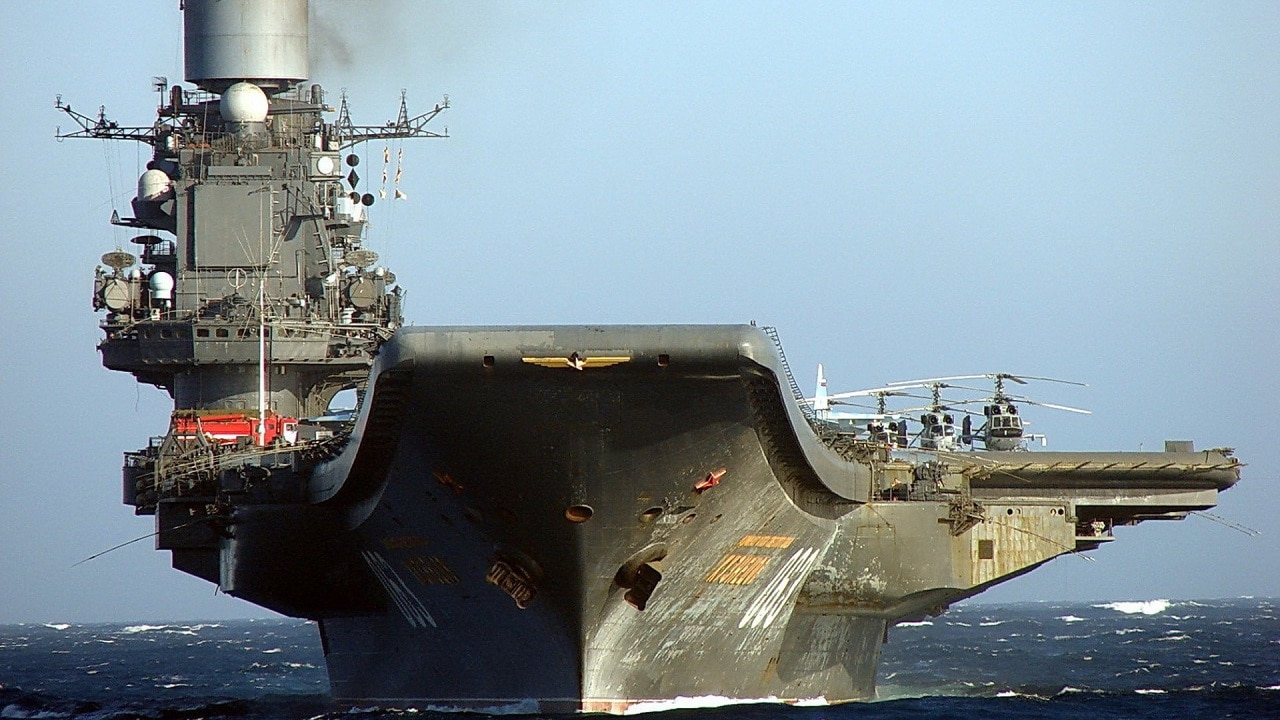Russia’s aircraft carrier, the Admiral Kuznetsov, was drydocked from 2017 until this past February.
The carrier has been subject to one mishap after another throughout its service life. In 2018, for instance, a 70-ton crane came crashing down onto the carrier, leaving a 16-foot gash on its deck after the PD-50 drydock holding the carrier sank.
Since entering service in 1991, the carrier has been a floating disaster. The Admiral Kuznetsov, which is believed to displace between 43,000 and 58,600 tons, is not likely to return to active service until late 2024. Depending on how sea trials go, that could be pushed back to 2025. Ukrainian intelligence estimates cast doubt even on that date, because no hard deadline exists for putting the aircraft carrier back into service.
As of yet, the Admiral Kuznetsov lacks a crew. Its previous complement stood at around 1,900 sailors.
The U.S. Navy Thought Russia’s Aircraft Carrier Could Sink
The carrier suffered a fire in 2009 following a short-circuit while it was deployed in the Mediterranean. A sailor died.
The U.S. Navy trailed the vessel in 2013 due to concerns it could sink.
During the Admiral Kuznetsov’s deployment in the Mediterranean in support of Russian operations in Syria in 2016, a Mig-29K crashed during a landing approach to the carrier. Separately, a Su-33 crashed after an arresting cable broke on the carrier’s deck.
Fires broke out aboard the carrier in 2019.
Ukrainian Intelligence Estimate: Admiral Kuznetsov Could Sink
Headlines have long mocked the Russian carrier, noting the acrid black smoke belching from its smokestack. It had to be attended by an oceangoing tug due to breakdowns.
“You can’t live on older ships. After 20 to 25 years, all you have is what’s left on the shelf,” Bryan Clark, a senior fellow at the Hudson Institute and Center for Strategic and Budgetary Analysis, told Business Insider.
He noted that older ships are prone to more frequent breakdowns and mishaps. As ships age, finding parts for them becomes harder. That leads systems to break down over time.
“Ship repairmen warned the military that the condition of Admiral Kuznetsov does not allow it to be deployed due to the high probability that it would sink or capsize. During the examination, it was revealed that the metal structures below the third deck of the ship were significantly corroded. The holds are filled with muddy water, which makes it impossible to examine the ship in detail from the inside,” Ukrainska Pravda reported, citing sources in Ukrainian intelligence.
Metal structures on the ship below its third deck are badly corroded, and muddy water fills its holds, making it hard to inspect. Russia’s 35th Ship Repair Plant and the Russian Northern Fleet have been locked in a bureaucratic blame game over who has responsibility.
Kuznetsov’s State of Affairs Suggests Russian Surface Fleet Not a Priority
The state of the Admiral Kuznetsov suggests that the Russian Navy lacks the ability to counter the U.S. Navy the way the Soviet Navy once did or like China has done.
The carrier’s sister ship, the incomplete former Soviet carrier Varyag, was bought from Ukraine in 1998 and completed by the Chinese People’s Liberation Army Navy as the Lionang, which has become a key part of China’s naval buildup. China built a second carrier from the keel up — the Shandong — based on the Admiral Kuznetsov’s design.
Aircraft carriers are extremely expensive to operate. The problems with Russia’s carrier suggest that Vladimir Putin’s Russia has other priorities than projecting naval power.
“Going forward, Russia is unlikely to replace this fleet, and its navy’s surface fleet will increasingly become a littoral force built around smaller surface combatants which operates close to Russian-held shores,” Sidharth Kaushal wrote in a June 2022 commentary for RUSI. “Despite Russia’s ambitious naval policy and plans to field a new generation of destroyers, its shipbuilding industry has shown few signs that it can deliver on Russian leaders’ aspirations. The weaknesses of Russia’s naval shipbuilding sector have been visible even in the delivery of smaller, less complex vessels, and will be especially acute if Russia does pursue large surface combatants.”
Kaushal continued, “The Russian surface fleet, then, is likely to devolve from a balanced fleet comprising both power projection capabilities and a cruise missile-equipped green water force into one based solely around the latter component.”
John Rossomando is a defense and counterterrorism analyst and served as Senior Analyst for Counterterrorism at The Investigative Project on Terrorism for eight years. His work has been featured in numerous publications such as The American Thinker, The National Interest, National Review Online, Daily Wire, Red Alert Politics, CNSNews.com, The Daily Caller, Human Events, Newsmax, The American Spectator, TownHall.com, and Crisis Magazine. He also served as senior managing editor of The Bulletin, a 100,000-circulation daily newspaper in Philadelphia, and received the Pennsylvania Associated Press Managing Editors first-place award for his reporting.
From the Vault
The Navy Sent 4 Battleships To Attack North Korea
‘Sir, We Hit a Russian Submarine’: A U.S. Navy Sub Collided with a Nuclear Attack Sub

